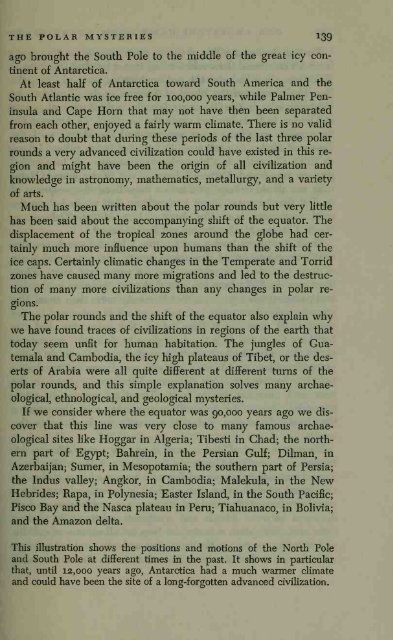Create successful ePaper yourself
Turn your PDF publications into a flip-book with our unique Google optimized e-Paper software.
THE POLAR MYSTERIES 139<br />
ago brought the South Pole to the middle of the great icy continent<br />
of Antarctica.<br />
At least half of Antarctica toward South America and the<br />
South Atlantic was ice free for 100,000 years, while Palmer Peninsula<br />
and Cape Horn that may not have then been separated<br />
from each other, enjoyed a fairly warm cHmate. There is no valid<br />
reason to doubt that during these periods of the last three polar<br />
rounds a very advanced civilization could have existed in this region<br />
and might have been the origin of all civilization and<br />
knowledge in astronomy, mathematics, metallurgy, and a variety<br />
of arts.<br />
Much has been written about the polar rounds but very little<br />
has been said about the accompanying shift of the equator. The<br />
displacement of the tropical zones around the globe had certainly<br />
much more influence upon humans than the shift<br />
of the<br />
ice caps. Certainly climatic changes in the Temperate and Torrid<br />
zones have caused many more migrations and led to the destruction<br />
of many more civilizations than any changes in polar regions.<br />
The polar rounds and the shift of the equator also explain why<br />
we have found traces of civilizations in regions of the earth that<br />
today seem unfit for human habitation. The jungles of Guatemala<br />
and Cambodia, the icy high plateaus of Tibet, or the deserts<br />
of Arabia were all quite different at different turns of the<br />
polar rounds, and this simple explanation solves many archaeological,<br />
ethnological, and geological mysteries.<br />
If we consider where the equator was 90,000 years ago we discover<br />
that this line was very close to many famous archaeological<br />
sites like Hoggar in Algeria; Tibesti in Chad; the northem<br />
part of Egypt; Bahrein, in the Persian Gulf; Dilman, in<br />
Azerbaijan; Sumer, in Mesopotamia; the southern part of Persia;<br />
the Indus valley; Angkor, in Cambodia; Malekula, in the New<br />
Hebrides; Rapa, in Polynesia; Easter Island, in the South Pacific;<br />
Pisco Bay and the Nasca plateau in Peru; Tiahuanaco, in Bolivia;<br />
and the Amazon delta.<br />
This illustration shows the positions and motions of the North Pole<br />
and South Pole at different times in the past. It shows in particular<br />
that, until 12,000 years ago, Antarctica had a much warmer climate<br />
and could have been the site of a long-forgotten advanced civilization.

















